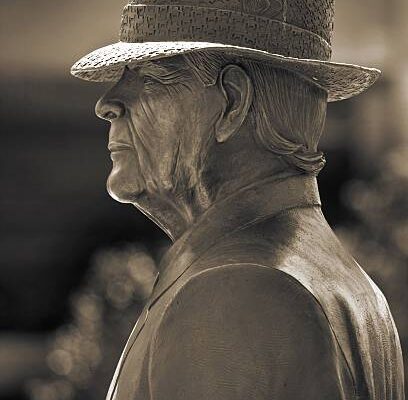It’s a simple square of paper, weathered and yellowed with time, protected now beneath glass in the hallowed halls of the Alabama Football Museum. The ink has faded, the handwriting barely legible, and the numbers are smudged in places. And yet, despite its fragile condition, that napkin holds an unmistakable and enduring power—a symbol of vision, belief, and the spark that helped build a modern football dynasty.
Most visitors to the museum pass the display with a moment of curiosity, leaning in to read the accompanying placard. But for those who know the full story, it’s not just a napkin—it’s a relic. It’s a reminder that history is often born not in grand stadiums or boardrooms, but in small, unassuming moments. That napkin captured one such moment—a turning point that would reshape Alabama football and alter the course of college athletics.
To understand its significance, we need to rewind to early 2007. Alabama football was at a crossroads. The once-dominant program had fallen into mediocrity, cycling through coaches and struggling to regain the dominance it once held under Bear Bryant. There were flashes of brilliance, moments of hope, but consistency was elusive. The fan base was restless. Expectations were enormous. The shadow of the past loomed large, and the future felt uncertain.
Enter Mal Moore, Alabama’s athletic director and a man with a deep, lifelong connection to the program. Moore understood the weight of tradition, but he also knew change was necessary. Alabama needed a coach who could not only restore pride but redefine what success meant in the modern era of college football. He needed someone who could recruit, motivate, build a culture, and win—consistently and convincingly. He needed a visionary.
That’s when the idea of Nick Saban began to surface.
At the time, Saban was head coach of the Miami Dolphins in the NFL. He had previously won a national championship with LSU in 2003 and was known for his meticulous nature, relentless work ethic, and almost clinical approach to building programs. But convincing him to leave the NFL and return to college was no small task.
The Alabama faithful were skeptical. Many thought Saban wouldn’t come. Others worried about how well his NFL experience would translate back to college football. But Mal Moore remained undeterred. Quietly and methodically, he pursued Saban. Conversations took place behind the scenes. Plans were floated. And then, one night in a quiet, off-the-record meeting, something remarkable happened.
Legend has it that during a dinner meeting—some say it was at a modest steakhouse, others recall a hotel bar—a napkin was pulled from the table. On it, stats were scribbled: recruiting advantages, potential win-loss projections, facilities upgrades, pipeline opportunities. But more than numbers, it was a vision—Saban’s vision. The stats may have been shaky, the handwriting rough, but the meaning was clear. This was the roadmap to dominance. This was the moment when belief met blueprint.
That napkin captured Nick Saban’s confidence that he could not only restore Alabama’s greatness but elevate it to heights previously unimagined. It was a mixture of analytics, intuition, and raw determination—distilled onto a disposable piece of paper. Some saw it as a recruiting pitch. Others saw it as strategy. But in hindsight, it was prophecy.
Soon after, the announcement came: Nick Saban was coming to Alabama.
The impact was immediate. Saban arrived in Tuscaloosa with a laser focus. He overhauled the program from the ground up. The “Process,” as it came to be known, emphasized discipline, preparation, attention to detail, and constant self-improvement. It wasn’t just about game plans; it was about mindset. Every player, coach, and staff member was expected to buy in. Every inch mattered.
And the results spoke for themselves. Over the next decade, Alabama became the gold standard in college football. National championships followed—in 2009, 2011, 2012, 2015, and 2017—with another title in 2020, further cementing Saban’s legacy. The program churned out NFL talent, dominated the recruiting landscape, and redefined what sustained excellence looked like in the sport.
Through all the trophies, draft picks, and headlines, that napkin remained a quiet symbol in the background. It became part of Alabama lore—mentioned in whispers, referenced in articles, cited in speeches. Fans debated what exactly was on it. Analysts tried to recreate it. But the real magic wasn’t in the ink—it was in the moment it represented. A moment when a coach saw what could be, and a program dared to believe again.
Eventually, the napkin found its way to the Alabama Football Museum. Preserved behind glass, it now draws thousands of visitors each year. Some stare in awe. Others smile knowingly. For longtime Alabama fans, it’s a tangible reminder of the program’s rebirth. For young fans, it’s a piece of living history, proof that greatness often starts with a single bold idea.
Coaches and sports historians have drawn comparisons between that napkin and other famous documents in sports history. Some liken it to Vince Lombardi’s first Green Bay Packers playbook. Others compare it to the hastily drawn route that birthed the “Immaculate Reception.” But the truth is, the napkin’s power lies in its simplicity. It wasn’t meant to be legendary—it just became that way.
There’s something profoundly human about that. In a sport defined by roaring crowds, billion-dollar TV contracts, and digital playbooks, the origin story of Alabama’s resurgence is refreshingly analog. Just a man, a pen, and a paper napkin. No PowerPoint, no fanfare, just vision and conviction.
That story has inspired not just football programs but business leaders, coaches from other sports, and individuals chasing their own dreams. The idea that you don’t need the perfect setting to articulate a transformative idea—that sometimes a back-of-the-napkin sketch is all it takes to change everything—is both humbling and empowering.
In recent years, as Saban approached the twilight of his coaching career, the legend of the napkin only grew. When he eventually retired, the moment was marked with emotional tributes, retrospectives, and celebrations of his unmatched career. And amidst all the accolades, the napkin remained a quiet but powerful presence—proof that even the most dominant dynasties can start with something as small as an idea and a belief.
It’s also a reminder of how leadership works. Mal Moore’s role in the story often gets overlooked, but his courage to pursue Saban, to trust in a vision others doubted, was pivotal. Without that belief, without that moment of alignment, the napkin might have stayed folded in a jacket pocket or tossed away with the dinner check. But because two men shared a moment of clarity and trust, history was set in motion.
Today, that napkin is more than a footnote in Alabama history—it’s a cornerstone. It’s part of the storytelling that defines the program. New recruits see it on visits. Fans take selfies with it. Coaches point to it as a reminder of where things began. It’s sacred not because of what’s on it, but because of what it came to mean.
So the next time you walk through the Alabama Football Museum, pause in front of that glass case. Look closely. Try to read the numbers. Imagine the scene. Picture the conversation. And remember: greatness doesn’t always start with fireworks. Sometimes, it starts with ink on a napkin and a dream too bold to be denied.
That napkin is a testament to foresight, risk, and the audacity to believe in something bigger. And in the world of Alabama football, it’s proof that even legends have humble beginnings.



